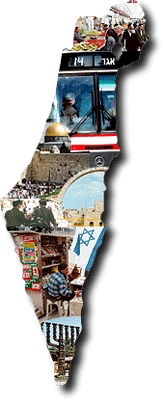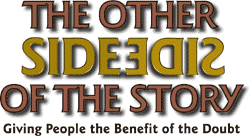Light Lines - Va'etchanan
Parshat Va'etchanan
11 Av 5760 / 12 August 2000
Ohr Somayach Home Page
THE MISSING LINK
G-d gave the Ten Commandments on two tablets of stone. Why not on one big stone? The commandments on the first tablet are between Man and G-d. "I am G-d... You shall not recognize the gods of others in My Presence..." The second tablet contains commandments between Man and his fellow: "You shall not murder; and you shall not commit adultery; and you shall not steal..."
Why do these "interpersonal" commandments need a separate slab?
Ultimately, nothing we do affects G-d. If we fail to do a mitzvah, G-d doesn't get angry. If we don't do it, He doesn't lack anything. G-d has no human traits, be they physical, emotional or spiritual. The commandments G-d gave us between us and Him are for one reason only: To connect us to Him. From His perspective, however, they do nothing.
Where our fellow beings are concerned, however, mitzvah failure (murder, theft, etc.) has a great impact.
That's why the 10 Commandments are divided between two tablets. The commandments between Man and G-d affect Man, but not G-d. Those between Man and Man affect both sides.
This link, this mutuality between the active party and the recipient, is alluded to by the linking of the second five commandments together with the conjunction "and." "You shall not murder; and you shall not commit adultery; and you shall not steal..."
When we damage the relationship with our fellow, it doesn't just affect ourselves, it impacts him as well. We are linked together.
|
Ohr Somayach Home Page |
 Selections from classical Torah sources which express the special relationship between the People of Israel and Eretz Yisrael PETACH TIKVA Founded in 1878 by some of the Jews from Jerusalem, this so-called "Mother of Agricultural Settlements" has developed into one of Israel's major urban centers. Its name comes from the prophecy of Hoshea, "I shall give her vineyards from there and the Valley of Achor for a petach tikva (door of hope)." The pioneers who established Petach Tikva, the oldest Jewish agricultural settlement of modern Israel, fought a heroic battle against malarial swamps and the area's citrus abundance and industrial activity are living monuments to their fortitude. Petach Tikva has a substantial religious community and boasts one of the country's leading yeshivot, Yeshivat Ohr Yisrael. |
|
Ohr Somayach Home Page |
Judging favorably means finding excuses for questionable behavior. When we find ourselves suspecting others, we must ask ourselves: Are there any redeeming factors? Did I miss something? For instance, take the case of the...
Verbal Eyes
"If people come to my lecture on a cold, rainy winter's night, why don't they at least listen?"
That's what I was thinking as I gave my emergency first-aid lecture. About ten minutes into my lecture, two women walked in, sat down in the back row and promptly started talking! It was extremely distracting to know that they had so little interest in my speech that they couldn't even stop gabbing for a minute!
About an hour later, I finished. And so, finally, did they. Gathering my notes and preparing to leave, I noticed the pair approaching me. At least they have the decency to come and apologize, I thought. But their apology was far from the one I expected.
"Thank you so much, Mrs. Frankel. We really enjoyed your talk," one said.
What? I thought. She's got to be kidding!
"I'd like to introduce myself and my sister," she continued. "Sorry we came late. We usually try to sit in the front row. But because of the rain, we had to drive slowly. You probably didn't notice, but as you were speaking, I was repeating what you were saying. My sister is hearing impaired, but she reads lips very well...."
|
Ohr Somayach Home Page |
A Wail of a Wall Which of the West?
Tammy Fannin wrote:
Can you tell me the historical and emotional significance of the Western wall of the Temple Mount to the people of today? Why do they go, what do they get from visiting? Can anyone go?
Dear Tammy,
The Holy Temple was the place where G-d's Presence was manifest among the Jewish People in ancient Israel. In the Holy Temple itself, the Divine Presence was most manifest in the western part. The ark containing the "two tablets" was in the west, and the western lamp of the menorah candelabra burned miraculously for centuries.
Even though the Temple was destroyed, the Western Wall remains until this day. This was foretold by the midrash which states "the Western Wall will never be destroyed, because the Divine Presence is manifest in the west."
But the history of this site goes back much further than the Temple. Our sources state that this was the place where Abraham offered his son Isaac, and it was here that Jacob envisioned the ladder. It was from this place that G-d took the earth from which He fashioned Adam, and it is the center of the universe, the point from which the universe was created.
Therefore, the Western Wall has a powerful spiritual and emotional pull on all humanity. People from all over the world are drawn there to interface with their souls' deepest yearnings.
Besides its spiritual significance, the Temple Mount is also of historical and archeological interest. Most of the western and southern walls of the Temple Mount date back to Herod's renovation of the Temple. There is a possibility that the lowest levels of these walls are from King Solomon's Temple. The northern wall dates back to Herod and the eastern wall is from the Second Temple of Nechemia, with some additions by the Hasmonean dynasty and some renovations by Herod.
Some of the stones are incredibly heavy, the transporting of which would have been extremely difficult. One of the stones is said to weigh approximately 628 tons! Archeological evidence indicates that the enormous stones were transported by rolling them on logs that were placed under the stones.
It is actually possible to see the Western Wall on the Internet. Just go to: www.ohr.edu and click on "KotelKam".
Light Insight | Love of the Land | The Other Side of the Story | Response Line Ohr Somayach Home Page |
Produced by the Office of Communications
Editor: Raphael Scott Leban
Production: Eliezer Shapiro
HTML Production: Michael Treblow
© 2000 Ohr Somayach International - All rights reserved. This publication may be distributed to another person intact without prior permission. We also encourage you to include this material in other publications, such as synagogue newsletters. However, we ask that you contact us beforehand for permission, and then send us a sample issue.
Ohr Somayach Institutions is an international network of Yeshivot and outreach centers, with branches in North America, Europe, South Africa and South America. The Central Campus in Jerusalem provides a full range of educational services for over 685 full-time students.









